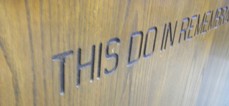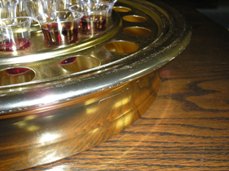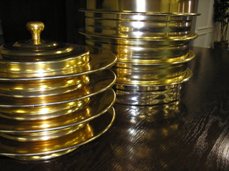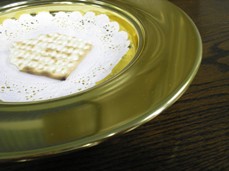Ancient Road Publications |
 |
|
The Lord's Supper A s
the children of Israel were coming out of their bondage in the land of Egypt
the Lord instituted a memorial that the Israelites were to keep as a reminder
of the great deliverance God granted them from the final plague that struck the
Egyptians. The Institution of the Lord’s Supper The gospels of Matthew, Mark, and Luke all record the Lord’s institution of this memorial (Matthew 26:26-29; Mark 14:22-25; Luke 22:17-20). In addition to this the Apostle Paul, in First Corinthians, responding to the Corinthian’s abuse of the memorial recounts the Lord’s institution of the Lord’s Supper (1 Corinthians 11:23-25). Let us observe what was involved in this institution. 1. “Then came the Day of Unleavened Bread, when the Passover must be killed” (Luke 22:7, NKJV). As Jesus met with His disciples on the night before His death, it was to observe the Passover meal. In accordance with the Law of Moses His disciples had prepared a place for them to eat the meal (Luke 22:8-12). This involved removing all leaven from the the house where the memorial was to be observed. The Passover began a period of seven days in which no leaven could be in their houses at all (Exodus 12:6, 15-18).  2. “And He took bread, gave thanks and broke it, and gave it to them, saying, ‘This is My body which is given for you; do this in remembrance of Me’” (Luke 22:19). While eating the Passover, Jesus took of the unleavened bread and gave thanks to God for it. He then broke the bread and gave it to each of the disciples. Both Matthew and Mark record His instruction, “Take, eat” (Matthew 26:26; Mark 14:22). Then Jesus told His disciples “This is My body.” With this Jesus set forth the significance of what was being done. The bread was a figure of Jesus’ body that was “given” (Luke 22:19) and “broken” (1 Corinthians 11:24) for His disciples. This was not to be done to satisfy hunger, but was to be done “in remembrance” of Jesus. 3. “Then He took the cup, and gave thanks, and gave it to them, saying, ‘Drink from it, all of you. For this is My blood of the new covenant, which is shed for many for the remission of sins” (Matthew 26:27,28). This cup, Jesus Himself called the “fruit of the vine” (Matthew 26:29; Mark 14:25 and Luke 22:18). It was to be a figure of the blood that Jesus would shed of the forgiveness of man’s sins. As with the bread, Paul tells us that Jesus told his disciples “this do, as often as you drink it, in remembrance of Me” (1 Corinthians 11:25). Observance of the Lord’s Supper The Bible offers us at least three examples of the observance of the Lord’s Supper among churches in the New Testament: 1. The church in Jerusalem; 2. The church in Troas, and 3. The church in Corinth. 1. The church in Jerusalem. After the outpouring of the Holy Spirit on the day of Pentecost, as recorded in Acts chapter two, the Bible records the establishment of the church in Jerusalem. After Peter and the others taught the people, the Bible tells us that 3000 souls heeded their message and were baptized (Acts 2:41). We are then told about the conduct of the church. Included in the list of their activities we are told that the Christians there continued steadfastly “in the breaking of bread” (Acts 2:42). 2. The church in Troas. As Paul traveled about teaching he came to the ancient city of Troas in modern day Turkey (Acts 20:6). While there, Scripture tells us, “Now on the first day of the week, when the disciples came together to break bread, Paul, ready to depart the next day, spoke to them and continued his message until midnight” (Acts 20:7).  3. The church in Corinth. In First Corinthians Paul refers to the Corinthians’ observance of the Lord’s Supper in two passages. The first comes in the midst of a discussion about Christians separating themselves from idolatry. In this passage Paul emphasizes that just as partaking of the bread and fruit of the vine unites Christians with the Lord and one another, if Christians eat things sacrificed to idols they unite themselves with idolatry (1 Cor. 10:15-22). The second reference addresses an abuse of the memorial that the Corinthians had committed. Instead of treating the Supper as the memorial observance the Lord intended, they had turned it into a common meal. Paul rebuked them, restates the details of the institution of the memorial, teaches them to eat at home for hunger, and commands them to observe the memorial with the right attitude (1 Cor. 11:17-34). Names of the Lord’s Supper • The Lord’s Supper. Paul uses the phrase most frequently used in this study in First Corinthians 11:20 referring to the memorial as “the Lord’s Supper.” • Communion. In the tenth chapter of First Corinthians Paul refers to the cup as “the communion of the blood of Christ” (10:16a) and the bread as “the communion of the body of Christ” (10:16b). The word translated “communion” is most frequently translated “fellowship” in the English New Testament. It is defined as “joint participation” (Thayer). In the institution of the Lord’s Supper Jesus said “Assuredly, I say to you, I will no longer drink of the fruit of the vine until that day when I drink it new in the kingdom of God” (Mark 14:25). The Christian who properly partakes of the Lord’s Supper is spiritually participating with Christ in the observance. In the same passage where Paul speaks of the memorial as the communion of the body and blood of Christ three other terms are used to refer to the elements of the Lord’s Supper. • The Cup of Blessing. The communion of the blood of Christ is identified as “the cup of blessing” (1 Cor. 10:16a). • The Cup of the Lord. Five verses later the same element is referred to as “the cup of the Lord” (1 Cor. 10:21). • Breaking of Bread. When Paul speaks of the communion of the body of Christ he identifies it as “the bread which we break” (1 Cor. 10:16b). The Lord’s Supper is never referred to in Scripture by the denominational name—the Eucharist. False Teaching on the Lord’s Supper 1. “The Lord’s Supper is a Sacrament.” A sacrament is thought to be a religious act by which Divine grace is dispersed. While it is true that all things that God gives to man can rightly be considered gifts of grace (see Romans 12:6), the Bible does not teach that partaking of the Lord’s Supper infuses a person with additional grace. Christians should observe the Lord’s Supper in obedience to Christ and for the edification which it offers to us. 2. “It Becomes the literal Body and Blood of Christ.” The Roman Catholic church, together with some Protestant churches, teach that the bread and fruit of the vine which are blessed by a priest are changed into the literal body and blood of Jesus. This stems from a misapplication of Jesus’ words in John chapter six. While Jesus taught in that text “…Most assuredly, I say to you, unless you eat the flesh of the Son of Man and drink His blood, you have no life in you” (John 6:53), He explained to His disciples at the end of the chapter that He was referring to spiritually feeding upon Jesus’ life and teaching. He clarifies near the end of the chapter “It is the Spirit who gives life; the flesh profits nothing. The words that I speak to you are spirit, and they are life” (John 6:63).  3. “It Can Be Observed Upon Any Day.” It is clear from Scripture that the observance of the Lord’s Supper was to be a congregational activity. In Paul’s rebuke to the Corinthians we see that it was to be done when Christians “come together as a church” (1 Cor. 11:18) when they “come together in one place” (1 Cor. 11:20). They were to eat at home to satisfy hunger (1 Cor. 11:34) and when they ate of the memorial they were to “wait for one another” (I Cor. 11:33). The only text that indicates a time when the memorial was observed specifies brethren coming together on Sunday— the first day of the week (Acts 20:7). While the phrase “breaking bread” can refer to either the memorial or a common meal, even when the church in Jerusalem met daily in the temple, their meals for hunger were satisfied “from house to house” (Acts 2:46). 4. “It Doesn’t Need to Be Observed Every Sunday.” It is clear that Christians met regularly on Sunday (see Acts 20:7 and 1 Corinthians 16:1-2). The only clear indication of the time upon which the Lord’s Supper was observed is Sunday (Acts 20:7). Given that no particular Sunday is specified and every week has a “first day of the week,” the only action that would truly comply with the New Testament pattern would be weekly observance. 5. “A Priest Alone Can Take the Cup.” The Bible teaches that all Christians are priests who offer up spiritual sacrifices to God (1 Peter 2:5). When Jesus instituted the memorial He gave both elements to His disciples and instructed them to partake. Matthew even reveals a specific statement Jesus made concerning the cup telling them “drink from it, all of you” (Matthew 26:27). Another person can’t drink the cup for someone else any more than another person can sing, confess Christ, or be baptized for someone else. 6. “There Must Be Only One Cup.” It is true that Paul spoke of the fruit of the vine as “the cup [singular] of the Lord” (1 Cor. 10:21) and “the cup [singular] of blessing” (1 Cor. 10:16) but this refers to unity of substance rather than unity of location. Technically, Luke records for us that Jesus first instructions concerned dividing the contents of the cup among the disciples present. Luke writes: “Then He took the cup, and gave thanks, and said, ‘Take this and divide it among yourselves’” (Luke 22:17). It is after the supper that He then attached memorial significance to the cup and had them drink from the contents of the cup He had previously divided among them (Luke 22:20). 7. “The Container Represents the New Covenant.” Some have falsely argued that the container is a figure of the New Covenant based on Jesus’ statement, “this cup is the new covenant in my blood” (Luke 22:20; 1 Cor. 11:25). It is clear from the texts that He is referring to the contents of the cup and not the container. We note that it is called the new covenant “in my blood.” A container does not represent blood, the fruit of the vine within the container does. Kyle Pope |
|
Home Studies Outlines Photos Graphics Fonts Books Tracts Hymns Contact Us |
 While the Lord struck dead the first born of everyone in Egypt,
those who observed the Lord’s instructions among the Jews were spared this
horror. From that time forward the Jews were to keep the Passover meal each
year in memory of when death had “passed over” their people (see Exodus 12).
It is not coincidence that on the night that Jesus observed the Passover with
His disciples, He instituted a similar memorial of His death for the children
of God under the New Covenant.
While the Lord struck dead the first born of everyone in Egypt,
those who observed the Lord’s instructions among the Jews were spared this
horror. From that time forward the Jews were to keep the Passover meal each
year in memory of when death had “passed over” their people (see Exodus 12).
It is not coincidence that on the night that Jesus observed the Passover with
His disciples, He instituted a similar memorial of His death for the children
of God under the New Covenant.